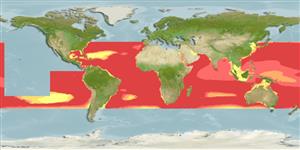Environment: milieu / climate zone / depth range / distribution range
Ecologia
marinhas batipelágico; intervalo de profundidade 0 - 2000 m (Ref. 27000). Deep-water; 40°N - 40°S, 180°W - 180°E
Worldwide in tropical and temperate waters (Ref. 33390). Western Atlantic: USA to Argentina. Eastern Atlantic: Azores to South Africa. Indian Ocean: Reunion (Ref. 33390). Southwest Pacific: Australia (Ref. 7300) and New Zealand (Ref. 5755).
Tamanho / Peso / Idade
Maturity: Lm ? range ? - ? cm
Max length : 143 cm TL macho/indeterminado; (Ref. 27000)
Pale in color with black lines between vertebrae (Ref. 3248).
Diurnal migrations (Ref. 51024). Feeds on crustaceans. Oviparous, strong sexual dimorphism (Ref. 3247).
Ciclo de vida ou comportamento de acasalamento
Maturities | Reprodução | Spawnings | Egg(s) | Fecundities | Larvas
Smith, D.G., 1990. Nemichthyidae. p. 199-202. In J.C. Quero, J.C. Hureau, C. Karrer, A. Post and L. Saldanha (eds.) Check-list of the fishes of the eastern tropical Atlantic (CLOFETA). JNICT, Lisbon; SEI, Paris; and UNESCO, Paris. Vol. 1. (Ref. 4456)
Status na Lista Vermelha da UICN (Ref. 130435)
Ameaça para os humanos
Harmless
Uso pelos humanos
Pescarias: sem interesse
Ferramentas
Relatórios especiais
Baixar XML
Fontes da internet
Estimates based on models
Preferred temperature (Ref.
123201): 5.4 - 14.9, mean 9 °C (based on 1405 cells).
Índice de diversidade filogenética (Ref.
82804): PD
50 = 0.6270 [Uniqueness, from 0.5 = low to 2.0 = high].
Bayesian length-weight: a=0.00102 (0.00046 - 0.00225), b=3.06 (2.88 - 3.24), in cm total length, based on all LWR estimates for this body shape (Ref.
93245).
Nível Trófico (Ref.
69278): 3.3 ±0.41 se; based on food items.
Resiliência (Ref.
120179): Baixo, tempo mínimo de duplicação da população 4,5 - 14 anos (Assuming tmax>10).
Fishing Vulnerability (Ref.
59153): Very high vulnerability (86 of 100).
